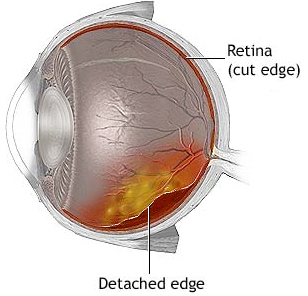Retinal Detachment: Time Critical Eye Emergency
 A detachment of the retinal can be a very serious and time critical emergency. A detached retina occurs when the retina pulls away from the supporting choroid (middle tissue) in the back of the eye, usually resulting from a hole in the retina that allows fluid to leak between the choroid and the retina.
A detachment of the retinal can be a very serious and time critical emergency. A detached retina occurs when the retina pulls away from the supporting choroid (middle tissue) in the back of the eye, usually resulting from a hole in the retina that allows fluid to leak between the choroid and the retina.
Since the retina cannot function properly under these conditions, permanent vision loss may occur if a detached retina is not repaired within 24 to 72 hours.
At Risk
Retinal Detachment is considered a risk for:
Nearsighted adults
People who have had an eye injury or post cataract extraction surgery
People with a family history of retinal detachment
People who have suffered a hard blow or sever trauma to the eye such as a contusion or penetrating wound.
There has been a rise in those under teenagers and young adults due to paintball injuries. Seconday detachments as a result of other diseases, such as tumors, severe inflammations or complications from diabetes.
Statistic for the United States show that nearly 28,000 cases of retinal detachment occurs each year. Most cases are a result of the processing of aging, affects a higher number of people with a Jewish heritage and occurs the least often among blacks.
Symptoms of retinal detachment include:
Flashes of light
Showering effect of floaters in the visual field
Darkening of the peripheral visual field.
Vision loss maybe filmy, cloudy, irregular or curtain-like.
One large floater in the middle of the field of vision or a wavy distortion of objects may also be a sign of a detached retina.
There is no pain associated with retinal detachment, but if you suffer from any of the above symptoms, see your eye doctor immediately. Often floaters will actually decrease as the retina detaches giving a false signal of possible a reversal in the condition when in truth the condition is worsening.
Diagnosis
Retinal detachment is diagnosed through an eye exam by a retinal specialist. The earlier the diagnosis is made, the greater the chance to restore vision. Diagnosis is based on symptoms and a thorough examination of the retina.
Treatment
Surgical treatment for retinal detachment depends on type, severity, and location of the detachment. Risks include infection, bleeding, cataract development, and increased pressure inside the eye. However, without intervention, retinal detachment usually causes permanent partial vision loss or blindness.
There are numerous approaches to treating retinal detachment. These include:
Laser (thermal) or freezing (cryopexy). Both of these approaches can repair a detached retina if it is diagnosed early enough.
Cryopexy. Cryopexy uses nitrous oxide to freeze the tissue behind the retinal tear, stimulating scar tissue formation that will seal the edges of the tear. It is usually done as an outpatient procedure, under local anesthesia.
Pneumatic retinopexy. This procedure can be used to treat retinal detachment if the tear is small and easy to close. A small gas bubble is injected into the vitreous where it then rises and presses against the retina, closing the tear. A laser or cryopexy can then be used to seal the tear. This procedure is 85% successful.
Scleral buckle. This treatment for retinal detachment involves placing a silicone band (buckle)around the eye to hold the retina in place. This band is not visible and remains permanently attached. Thermal treatment may then be necessary to close the tear. This procedure is effective as high as 95% of the time.
Vitrectomy. This procedure for retinal detachment is used for large tears. During a vitrectomy the vitreous is removed from the eye and replaced with a saline solution. It has similar success rates to the scleral buckle.
About 80 percent of all uncomplicated cases can be cured with one operation; an additional 15 percent will need repeated operations and the remainder will never reattach. The prognosis is worse if the macula is detached or if the detachment is of long duration.
Without treatment, retinal detachment often becomes total within six (6) months. Unfortunately, due to continual shrinkage of the vitreous and the development of fibrous growths on the retina, not all retinas can be reattached. If the retina cannot be reattached, then the eye will continue to lose sight and ultimately become blind.
Prevention
Preventing age-related retinal detachment is possible by having regular eye exams and seeing an eye care practitioner immediately when early symptoms (floaters and flashes) are experienced. In most cases, small tears can be repaired easily and vision can be preserved. People at high risk should discuss the frequency of eye exams with their practitioner.
To avoid eye injuries, which may lead to a retinal, detachment use safety glasses or goggles when participating in activities that may have a high risk for eye injuries such as paintball guns, racket ball and many other sports.
For additional information or to schedule an Eye Examination, please contact us at 1.866.611-7556.
Serving:
Sealy, TX - Bellville, TX - Columbus, TX - Katy, TX |
